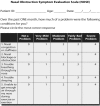Quality of Life in Patients with Nasal Septal Deviation After Septal Correction
- PMID: 31763324
- PMCID: PMC6848472
- DOI: 10.1007/s12070-019-01689-9
Quality of Life in Patients with Nasal Septal Deviation After Septal Correction
Abstract
Septal Correction is an age-old procedure being practiced for the major part of a century now. The aim of this study was to assess the quality of life after Septal Correction. Fifty patients with complaints of nasal obstruction, trouble breathing via the nose, headache and facial pain were selected for the study. Initial pre-operative assessment was done based on a symptomatic score [Nasal Obstruction Symptom Evaluation Scale (NOSE Scale)]. The presence of a septal deviation was confirmed with an X-ray and computed tomography of the paranasal sinuses along with a diagnostic nasal endoscopy. Based on the extent and location of deviation, the malformed part was corrected. Post-operative assessment was done after a period of 8 weeks based on the NOSE Scale. The results were co-related and documented. It was found that the scores were better post-surgery. Thus, it can be concluded that Septal Correction as a surgical procedure is still relevant in today's World for symptomatic betterment and for a healthier lifestyle.
Keywords: Deviated nasal septum; Nasal Obstruction Symptom Evaluation; Quality of life; Septal Correction.
© Association of Otolaryngologists of India 2019.
Conflict of interest statement
Conflict of interestThere were no conflicts of interest in the conduct of this study.
Figures
References
-
- Killian G. The submucous window resection of the Nasal Septum. Ann Otol Rhinol Laryngol. 1905;14:363–393. doi: 10.1177/000348940501400210. - DOI
-
- Freer OT. The correction of deflections of the Nasal Septum with a minimum of traumatism. JAMA. 1902;XXXVIII:636–642. doi: 10.1001/jama.1902.62480100012002b. - DOI
LinkOut - more resources
Full Text Sources



